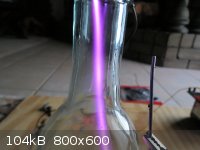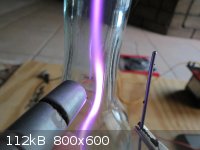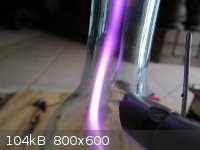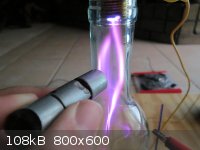Gooferking Science
Hazard to Self
 
Posts: 97
Registered: 17-7-2013
Location: Somewhere in Kansas, USA...
Member Is Offline
Mood: Halogenated
|
|
Strange deflection properties of a cathode ray
Hello. I have been experimenting with my newly constructed cathode ray tube and I have found a really weird property of the beam. I thought that when
I held a magnet up to the the beam it would either directly attract or directly repel from it. What actually happened is when I held a magnet to the
beam, it would attract to it, but it would always curve around it to the left. When I held the opposite side of the magnet to it, it would repel it,
but always to the right. Curious, I wondered what would happen if I switched the positive and negative terminals. As I had guessed, now it would
attract and curve to the right, and repel to the left. Why is this happening? Does it have to do with the electrons in the magnet repelling the
electrons in the cathode ray? Here are some pictures:

Here is the tube operating with no magnet.

Here are the electrons deflecting to the right.

Here are the electrons attracting to the left.

When I apply a magnetic field to the beam while it is operating on an alternating current, it seems to "split". My guess is that this is happening
because the alternating current is switching directing faster than the eye can see. Since it is switching direction, it is also switching which
direction is takes around the magnet. It is basically like when I switched the electrodes when operating on a DC current, just much quicker.
|
|
|
Steve_hi
Hazard to Others
  
Posts: 196
Registered: 4-12-2010
Member Is Offline
Mood: No Mood
|
|
Will you be making a you tubevideo of your cathode ray tube?
[Edited on 16-2-2014 by Steve_hi]
|
|
|
Artemus Gordon
Hazard to Others
  
Posts: 178
Registered: 1-8-2013
Member Is Offline
Mood: No Mood
|
|
I think the issue has to do with the magnetic force lines curving from the north to south poles of your magnet. Linus Pauling's General
Chemistry has line drawings of some of the early cathode ray tube experiments, and they all show horseshoe-shaped magnets such that the north
pole is on one side of the beam and the south pole is on the opposite side. This would cause the force lines to travel a short straight path from pole
to pole through the beam.
Electric fields and magnetic fields do not directly attract or repel. They work at right angles to each other. So, imagine your CR beam is traveling
horizontally from west to east. If you add a horseshoe magnet with the north pole north of the beam and the south pole south of the beam you could
think of that as a magnetic current also traveling horizontally but at right angles to your CR beam. This would not bend the beam either to the north
nor to the south but would bend it UPWARD.
I congratulate you on a very impressive job of constructing a CRT!
[Edited on 16-2-2014 by Artemus Gordon]
|
|
|
Varmint
Hazard to Others
  
Posts: 264
Registered: 30-5-2013
Location: Near Atlanta, GA
Member Is Offline
Mood: No Mood
|
|
Fact check:
What is the (gas) content of the tube?
That looks a lot more like excited gases than anything else.
If that is a cathode ray, the current density is such that your are being bombarded by X-Rays, and are placing your health in jeopardy.
Watch this vid in it's entirety please:
http://www.youtube.com/watch?v=aR7nlqFC9EI
DAS
|
|
|
IrC
International Hazard
    
Posts: 2710
Registered: 7-3-2005
Location: Eureka
Member Is Offline
Mood: Discovering
|
|
I highly doubt he is in danger of being cooked. Looks like a simple arc in a rarefied gas to me. A little high on current but so what. I don't think
CRT is the correct term, as it does not look like an electron gun is involved. More like two electrodes with an arc between them. No need for paranoia
IMHO.
Of course it would be helpful if he provided better detail and information beyond a few pics. If he is running much beyond 25 KV you may have a point.
Depending upon gas pressure it would not take all that great of a potential to produce an arc.
"Science is the belief in the ignorance of the experts" Richard Feynman
|
|
|
Gooferking Science
Hazard to Self
 
Posts: 97
Registered: 17-7-2013
Location: Somewhere in Kansas, USA...
Member Is Offline
Mood: Halogenated
|
|
Please excuse me for leaving out information. I am running this on 10,000 - 12,000 volts at 23 mA . I am using a generally low vacuum, so the glow is
definitely from ionized gas. The glow helps to visualize the beam. I guess CRT probably isn't the most correct term for the project... Maybe electron
beam would be better. It is simply an arc in a vacuum, but isn't that what early crooke's tubes were? I don't think there is any danger of x-rays.
|
|
|
Gooferking Science
Hazard to Self
 
Posts: 97
Registered: 17-7-2013
Location: Somewhere in Kansas, USA...
Member Is Offline
Mood: Halogenated
|
|
Thanks for sticking up for me IrC! I completely agree with you.
Varmint - I am only in 8th grade, and have no formal training in physics. I do take chemistry at the local college. I do all of my projects at my
house on a limited budget. I am only trying to learn
-Stuff likely to cause further flaming removed-
[Edited on 17-2-14 by The_Davster]
|
|
|
vmelkon
National Hazard
   
Posts: 669
Registered: 25-11-2011
Location: Canada
Member Is Offline
Mood: autoerotic asphyxiation
|
|
Quote: Originally posted by Artemus Gordon  | I think the issue has to do with the magnetic force lines curving from the north to south poles of your magnet. Linus Pauling's General
Chemistry has line drawings of some of the early cathode ray tube experiments, and they all show horseshoe-shaped magnets such that the north
pole is on one side of the beam and the south pole is on the opposite side. This would cause the force lines to travel a short straight path from pole
to pole through the beam.
Electric fields and magnetic fields do not directly attract or repel. They work at right angles to each other. So, imagine your CR beam is traveling
horizontally from west to east. If you add a horseshoe magnet with the north pole north of the beam and the south pole south of the beam you could
think of that as a magnetic current also traveling horizontally but at right angles to your CR beam. This would not bend the beam either to the north
nor to the south but would bend it UPWARD.
I congratulate you on a very impressive job of constructing a CRT!
[Edited on 16-2-2014 by Artemus Gordon] |
Yes, it is a good idea to have a horse shoe magnet in this case. He can make a horshoe electromagnetic if he gets a iron bar and bends it and wraps
wire in the correct direction.
The direction that the beam would go to depends on which electrode is the negative and which is the positive.
Electrons go to the + and the cations (nitrogen and oxygen and who knows what) goes to the -.
Both the electrons and cations will generate a magnetic field in the same direction since they are traveling at opposing directions.
If you place your magnet, the beam will be in one direction.
Example:
________________||||north pole||||
(cathode)===================(anode)
________________||||south pole||||
The beam should go outside of the page (towards you).
Signature ==== Is this my youtube page? https://www.youtube.com/watch?v=tA5PYtul5aU
We must attach the electrodes of knowledge to the nipples of ignorance and give a few good jolts.
Yes my evolutionary friends. We are all homos here. |
|
|
gatewaycityca
Harmless

Posts: 27
Registered: 8-2-2014
Member Is Offline
Mood: No Mood
|
|
Gooferking Science, I just wanted to say your discharge tube is beautiful! I love that glow, and that is one of the reasons I like experimenting with
high voltage. The phenomenon you can see is truly amazing.
Also, I can't believe you're only in 8th grade! You're just a kid! What you are doing is absolutely incredible for your age! Keep it up. Stay
curious, keep experimenting, and keep learning. Have fun. Just be safe. 
|
|
|
Chemosynthetic
Harmless

Posts: 19
Registered: 12-11-2013
Member Is Offline
Mood: No Mood
|
|
I completely agree! Very impressive! I wish I were as scientifically productive at your age. One of my friends in high school always had my
admiration for his Leyden jars and the like, and I always wished I had such a supportive family like that. Luckily, my family did get me an organic
setup after awhile, so that helped immensely.
|
|
|
woelen
Super Administrator
        
Posts: 7976
Registered: 20-8-2005
Location: Netherlands
Member Is Offline
Mood: interested
|
|
First I want to say that this experiment is a fantastic one, especially if we take into account your age. Good to share this.
I think that there are two effects which cause deflection of your beam:
One of them will be due to static charge attraction. This force is in the direction of the object which attracts (or repels) the charge. I think that
this part of the force will not be that high, you have no charged object nearby, but in practice you will always have some of this effect.
The other (and main) effect is due to the force, caused by a magnetic field on a moving charge. This force is in a direction perpendicular to
the magnetic field lines and perpendicular to the direction of motion. If you regard the flow of charge as a vector and the magnetic field as a
vector, then the force on the charged particles can be written as a cross product of these two vectors. The math may be beyond you, but if
you search for this term, then you may get a qualitative idea.
The curving is due to the change of direction of the beam and due to non-uniformity of the magnetic field. The cross product then also points in
another direction and so you do not have a simple bend, but a continuous bending pattern at different places in space. The result is a complicated
curve. You only get nice simple curves if you work with a sharp beam and a uniform field.
It may also be interesting for you to look up the term "Lorentz force".
[Edited on 17-2-14 by woelen]
|
|
|
Chemosynthesis
International Hazard
    
Posts: 1071
Registered: 26-9-2013
Member Is Offline
Mood: No Mood
|
|
For future use, Gooferking Science:
http://www.nist.gov/pml/data/xraycoef/
|
|
|
bfesser
|
Thread Split
17-2-2014 at 09:06 |